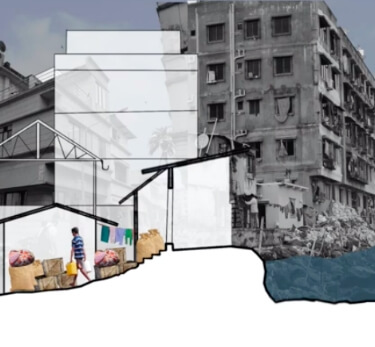GALLERY 04 | SALINE WATERS
EXHIBIT 03/03
Time and Tide: Cyclic Routines of Life Around Water




Kolis in Mumbai have historically settled along the coast, while smaller migrant communities have settled along rivers. These communities developed an interdependence with water - sourcing freshwater for daily use for small-scale agriculture and growing flowers for garlands. Although the people were not native to the area, they had immense respect for the rivers and the seas. Urbanisation, climate change and sea level rise have led to the containment of these rivers to reduce the impact of ‘flooding’.
Largely living along the flood plains, these communities depend on the seasonal river for their work. Over the years they have developed ways and means to combat/endure and adapt to the wetness during monsoons. While some find ways to continue to live in their houses, others are forced to migrate to higher lands, carrying what little personal belongings they are able to retain over many years. This cycle continues year after year…
ऐतिहासिक काळापासून मुंबईच्या किनारपट्टी लगत कोळी लोकांच्या; तर इतर लहान-सहान स्थलांतरित ज्ञाती मुंबईतील नद्यांकाठी वसल्या गेल्या. त्यांचे जीवन बहुतांशी पाण्यावरच अवलंबून होते आणि आहे- पिण्यासाठी लागणारे पाणी, लहानमोठ्या प्रमाणात करत असलेल्या शेतासाठीचे पाणी, तोरणं आणि हार बनविण्यासाठी लागणार्या फुलझाडांसाठीचे पाणी. ही लोकं जरी येथील मुळ रहिवासी नसले, तरी या नदी आणि समुद्राबाबत त्यांना अत्यंत आदर होता. वाढते शहरीकरण, हवामान बदल, समुद्राच्या पातळीची वाढ या सर्वांचा एकत्रित परिणाम म्हणजे पूर. पूर परिस्थिती नियंत्रणात ठेवण्यासाठी नदीचे पात्र ताब्यात ठेवणे आवश्यक झाले.
येथील बरीचशी वस्ती सखल भागात आहे. दर पावसाळ्यात इथे पूर येतोच. परंतु, याच मौसमी नद्यांवर यांचे जीवन अवलंबून होते. काँक्रिटीकरणामुळे या नद्यांच्या प्रवाहावर विपरीत परिणाम झाला असून आणि इथे कधी एकेकाळी नदी होती असे सांगायची वेळ आली. नदीच्या पात्राचे काँक्रिटीकरण केल्याने ही परिस्थिती आपण स्वत:हून ओढवून घेतली आहे. त्यावर स्थानिकांनी आपापल्या परीने उपाय शोधला आहे. काही जण तिथेच राहून परिस्थीशी दोन हात करतात, तर ज्यांना शक्य असेल ते आत्तापर्यंत जमविलेले आणि जमेल ते बरोबर घेऊन स्थलांतरित होतात. हे चक्र असंच वर्षानुवर्षे चालू आहे....
People living closer to the sea, and thus in contant anticipation of floods, develop stories to explain its erratic behaviour. These stories often become legends of the community and are passed down various generations. One such story is told to a boy living in Bhati Koliwada. As he looks at the seemingly floating rock pointed out to him in the sea, his father tells him of the possibility of a day when that rock will no longer be seen. The boy looks at the rock in wonder, knowing it stayed afloat on that fateful day when the city drowned. His little mind cannot comprehend what will happen to the city on a day the rock succumbs to ocean’s waves…
Versova Koliwada has been seeing an increasing number of migrants. These migrants who had come to the city in search of work build houses along the beach, atop a pile of sediments deposited by the sea. They build using disposed GI sheets and tarpaulin. Every year, floods during the monsoon, coupled with tidal forces, and the sea swipes their houses away. Every year they source the same materials to remake them on a pile higher than the previous one, with each level being added by the pile of the previous year’s materials.
They say water always finds its way. After channelising the rivers in the city, the seasonal fresh water sources were reduced to large nullahs and an increase in the grey water being discharged into them from surrounding settlements was observed. Incidentally, the very pipes that were used to discharge the water into the river began to force water back out during the monsoons when the river swelled, creating a backflow of mucky water from weep holes and drain pipes. As a result of this, several houses in the settlements along the River Poisar are seen to have a higher floor where the people live out the monsoons. This yearly affair entails the transfer of all the belongings of the house from the ground floor to the higher floor, every year.
The term living off a suitcase may seem like a sign of affluence to many. In several parts of the city, groups of people are forced to live off of the proverbial suitcase, but as a result of adversity. On this little mass of land in the middle of the seasonal River Poisar, the people are seen storing food, water and the small number of valuables they can afford in plastic drums and old aluminium cans. Every year, they are forced to move to a higher ground while their houses flood due to the ever-increasing flow of the river.